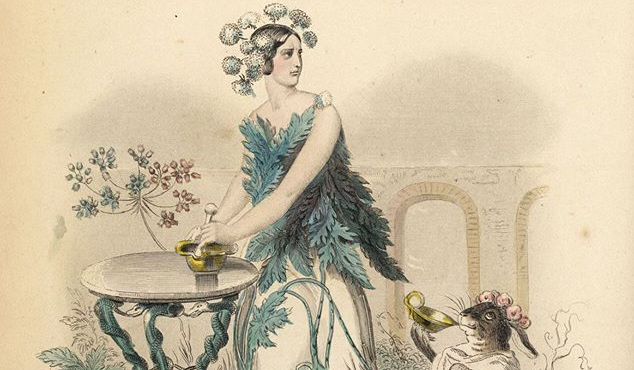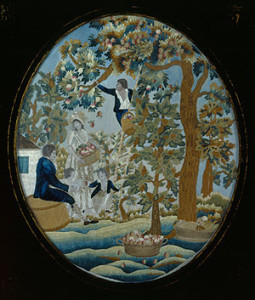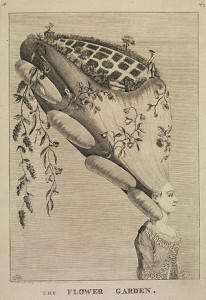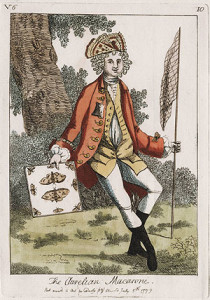Flora and Femininity: Gender and Botany in Early America

In March of 1823 schoolmaster Caleb Burge notified readers of the Hartford Connecticut Courant that his school for young ladies would open the following month in the town of Glastonbury. In addition to instruction in the branches of education “usually taught in Female Academies,” Burge offered his pupils a course of lectures on the “very fashionable, useful and pleasing” science of botany. Burge’s school was just one of many that dotted the landscape (especially in New England) in the early years of the nineteenth century. Burge was not unique in providing botanical instruction; this branch of natural philosophy drew increasing numbers of female students and practitioners.
Anglo-American women’s acquaintance with the natural world was tied to early exploration and settlement. Colonists were scientifically curious about North American flora and fauna, but they also had a practical need to harvest plants and animals. Bioprospectors contributed to knowledge of new and often unfamiliar environments. Seeds, plants, and animals were collected, shared, traded, and studied. John Bartram, the eighteenth-century Philadelphia botanist, for example, was embedded in a transatlantic network of scientific inquiry fostered by British gentlemen-scientists such as London-based merchant Peter Collinson, a Royal Society Fellow who financed Bartram’s North American collecting journeys, and Royal Society president Sir Hans Sloane, whose natural history collections and cabinet of curiosities formed the basis of the British Museum. Many American plants grew well in British gardens. From their new Old World home, botanical specimens were transformed into objects for study and delight. Curiosity about American nature fit well with the literary and artistic interests of Georgian Britain and America. Augustan pastoral poetry celebrated the natural world. Accurate and beautiful prints of North American flora graced American walls. These same prints were copied onto ceramics—Americans dined off imported Chelsea plates and sipped tea from cups that showcased the continent’s botanical abundance.
Immersed in this aesthetisized botanical world, women expressed their interest in, and knowledge of, nature through a gendered material culture. Floral designs abounded on English textiles ordered by colonists. Not merely idealized florals, these designs were often copied, as the Chelsea tableware was, directly from botanical prints. American women also created their own botanical fabric: some colonial quilters, through judicious and creative use of costly or scarce textiles, fashioned nature studies in the quilting style known as broderie perse. Women also evoked the pastoral landscapes of Augustan poetry in needlework. Especially popular were scenes copied from the illustrated versions of James Thomson’s poem, “The Seasons” (1730). “Autumn,” for example, an embroidered picture by student Sally Phelps at the Litchfield Academy in Connecticut, depicts an orchard scene with trees laden with apples and two young men and a woman collecting the fruit. This genre of landscape work was a standard part of drawing as well as needlecraft instruction in early nineteenth-century girls’ schools such as the Litchfield Academy, where Clarissa Deming chose a more personal image to showcase both her drawing skills and her horticultural knowledge: her map is correctly labeled with the different varieties of fruit trees that grew in her family’s orchard.

British women in the Atlantic world dressed themselves, their beds, their walls and firescreens—even their hair—with reminders of American floral abundance. English author Hannah More described this fashion to a correspondent in 1777: “The other night we had a great deal of company—eleven damsels to say nothing of men. I protest I hardly do them justice when I pronounce that they had, amongst them, on their heads, an acre and a half of shrubbery, besides slopes, grass plots, tulip beds, clumps of peonies, kitchen gardens and greenhouses.” More’s comment, though exaggerated, was a response to a style popular among the metropole’s fashionable elites.
Embroidered orchards and peony hair ornaments testify that women were practitioners of floral display, but many women sought knowledge as well as style. Linnaean taxonomy gave order to the botanical world; plants could be identified and classified by anyone once they mastered Linnaeus’s straightforward system based on the sexual characteristics of plants. Jane Colden is perhaps the best example of an eighteenth-century American woman who diligently studied the Linnaean system (albeit in English rather than Latin). As a teenager living with her father, the scientist Cadwallader Colden, in New York’s Hudson Valley, she put her knowledge into practice by classifying over 300 species of local plants in the 1750s. British collector Peter Collinson learned of Jane Colden’s achievements through correspondence with her father, and Collinson passed on to Linnaeus himself the fact that Jane Colden was “perhaps the first lady that has perfectly studied Linnaeus’ system.” Colden continued her botanical studies up until her marriage, at age thirty-five, in 1759. She passed away the following year. Her notebook, carefully preserved by her family, eventually found its way into the Natural History Museum in London.

How could a woman on the periphery of empire have mastered the precepts of botanical science? Print culture provides at least part of the answer. Colden read some of the imported botanical texts available to Americans through direct shipments from overseas acquaintances. Her father requested Peter Collinson to send a variety of botanical illustrations and texts from London: “As [she] cannot have the opportunity of seeing plants in a Botanical Garden I think the next best is to see the best cuts or pictures of them for which purpose I would buy for her Tournefort’s Institutiones [Rei] Herbariae, Morison’s Historia Plantarum, or if you know any better books for this purpose as you are a better judge than I am will be obliged to you in making this choice.” By the close of the eighteenth century, British women authored as well as read botanical texts. Priscilla Wakefield’s An Introduction to Botany, in a Familiar Series of Letters (1796) was the first of many instruction books aimed at an amateur reader. Sarah Fitton’s Conversations on Botany (1817) and Jane Marcet’s Conversations on Vegetable Physiology (1829) were among the most popular works in the early nineteenth century, competing with Wakefield’s text, which continued to appear on booksellers’ lists. Occasionally we can document that specific American women read these works: Philadelphian Rueben Haines kept a lending record of his books. In 1805 his friends Martha Robeson, Susan Emlen and Lydia Coates each borrowed Wakefield’s An Introduction to Botany. The titles suggest why these books appealed to women: all three authors placed botanical instruction within an intimate setting; learning botany was something to do within a circle of friends (such as the epistolary correspondence of Wakefield’s characters), or between a mother and child (in Fitton’s book, a mother talks with her young son). Learning was conversation, rather than a rigorous drill. Nevertheless, all three authors emphasized that botanic study was an active exercise, one ideally performed out of doors. Wakefield encouraged her readers to leave the parlor and walk among the plants, and to examine living samples with a microscope small enough to fit in a female pocket.
Women clearly were interested in botany. Whether or not botany was deemed to be a suitable occupation for women is another matter. Two gendered portrayals of female practitioners in the early eighteenth century show how some men depicted such women. German Naturalist and artist Maria Sibylla Merian, who travelled to Surinam in 1699 with her daughter, produced a comprehensive volume,Metamorphosis Insectorum Surinamensium, on the insects and flora of the colony. Merian was knowledgeable and thorough: she bred insects so she could illustrate each stage of the life cycle. A portrait painted during her lifetime shows her as a scholar, surrounded by instruments, books and the insects she studied. Yet the frontispiece to an edition of her work published after her death shows Merian seated calmly at a table while at her feet, mischievous putti rummage through collections of flora and other study objects. Alan Bewell has suggested that this maternal, rather than scientific, depiction of Merian may have “reduc[ed] social anxieties raised by the unconventional aspects of Merian’s life by [intimating] that ultimately her primary commitment as a female naturalist was to domestic family life, not to the study of nature.”
A retreat to domesticity in order to raise the comfort level of the early eighteenth-century readers of Merian’s work was not the only strategy employed by men who encountered botanically savvy women. Charleston, South Carolina, nursery owner Martha Logan procured plants for customers in the colonies and Britain. When John Bartram met Logan during his southern tour in the 1760s, he paid her the compliment (in a letter to Peter Collinson rather than to Logan herself) that she knew her horticulture well. Logan’s own letters confirm how knowledgeable she was, and they demonstrate that she was part of a local network of fellow horticulturists, some of whom were women. Logan’s Gardener’s Calender, which instructed southern gardeners about what, and when, to plant, was printed at the back of South Carolina almanacs until the end of the eighteenth century. Yet Bartram thought of her quite differently than he thought of male practitioners. To Collinson, Bartram described Logan as his “fascinated widow,” a sexualized creature who panted after him. Bartram bragged to Collinson that he had also fascinated two other women: “two men’s wives, although one I never saw; that is, Mrs. LAMBOLL, who hath sent me two noble cargoes; one last fall, the other this spring. The other hath sent me, I think, a great curiosity. She calls it a Golden Lily.” Needless to say, Bartram had a rather exaggerated opinion of his ability to “fascinate.” And note that he uses fascinated rather than fascinating—indicating that he had done the fascinating, not that he found these women to be so. In Bartram’s depiction of Logan, Lamboll, and the unknown wife, women used plants as tribute or enticement, but not as a straightforward exchange of botanical specimens among equals.

Women’s botanical activity raised concerns because it removed them from the domestic sphere and because it placed women within a heretofore masculine network of plant fanciers. But not everyone feared that women who studied the natural world threatened the gender status quo. Wakefield’s popular An Introduction to Botany, and the nineteenth-century works that followed hers, seamlessly incorporated science study with maternity and domesticity. Author and lecturer Benjamin Tucker believed that botany was a suitable subject for women, though other “walks of science” he explained, “must be trod by men alone.” Charles Willson Peale assured parents that girls would readily take to science generally: “The lively fancy of the youthful fair, would quickly catch a fondness for a science of such infinite variety.” He observed that girls’ “fondness” would yield social benefits: “What a charming topic for conversation would this [scientific knowledge] afford in their social parties! And if we reflect how the various parts of natural science branch out into all the household and economical concerns, can we find any part of female education of greater import?” An anonymous letter to the Pennsylvania Packet in 1790 by “A Lover of Nature” praised Peale’s museum as an educational tool for girls: “a young lady, with all her taste in finery, is wanting in fine taste if she has no desire to be acquainted with the sweet little humming bird, the gay paradise bird, the golden pheasant, the beauteous ring-dove, and many other lovely fellow beings.” These sentiments echoed those expressed earlier by Jane Colden’s father, who in 1755 wrote to the Dutch naturalist Jan Frederik Grovonius, “I thought that Botany is an Amusement which may be made agreeable for the Ladies who are often at a loss to fill up their time if it could be made agreeable to them[.] Their natural curiosity and the pleasure they take in the beauty and variety of dress seems to fit them for it.”
In all three instances these arguments for female learning took a gendered perspective: Peale assumed that sociability and domesticity determined appropriate subjects for instruction. The anonymous “Lover of Nature” linked a woman’s fondness for display to an interest in natural history. Cadwallader Colden also believed that women’s love for adornment would make flowers (though perhaps not the drab ones) an attractive subject for study in what Colden assumed to be a woman’s otherwise unoccupied hours. When Rueben Haines described to his friend James Parke a botany lecture Haines and his wife attended in New York City in 1812, he expressed the hope that “the young of Linnaeus of this city may particularly among its fair inhabitants diffuse a knowledge of and create a taste for the Science which thee ardently loves.” That Haines used the expression “a taste for” botany suggests that it was both a genteel pursuit, and, like the sentiments expressed by the anonymous “Lover of Nature,” botany complemented women’s attraction to visually pleasing objects. Another Haines friend, the ichthyologist Samuel Latham Mitchell, went further in this linkage of women and flowers. After learning of the success of a series of botanical lectures for women at the Academy of Natural Sciences in Philadelphia, Mitchell commented, “I am glad to hear that your Philadelphia damsels are indulging their taste for Botany. It will be a charming employment for those whose situation in life likens them to the lilies of the valley … It would gratify me highly to step in, and take a seat among these blooming daughters of Flora.” Mitchell’s response underlines the tension implicit in women’s presence at such public lectures: they were both observers and the observed, objects of desire as well as subjects for scientific education.

But feminizing science provoked another set of anxieties concerning male practitioners. Satirist Matthew Darley chose to portray botanist Daniel Solander and entomologist Moses Harris in Macaroni style. Macaronis, those fashionable dandies who wore elaborate wigs and tricorn hats, challenged masculine gender identity with their feminized dress and foppish, unmanly mannerisms. As the Oxford magazine observed in 1770, “there is indeed a kind of animal, neither male nor female, a thing called a Macaroni.” The Simpling Macaroni depicts Linnaean protegé Solander, whom Sir Joseph Banks employed to assist him in collecting and describing plant specimens taken on Cook’s first Pacific voyage, as a fat dandy. He grasps his pruning knife in one hand and an oversized vegetable in the other. The Aurelian Macaroni, Moses Harris, is so devoted to his bugs that he has begun to turn into one himself: his wig is composed of caterpillars, his hat is made of butterfly wings and his coat buttons are living snails. Rousseau, though himself a gardening enthusiast, complained of such men: “Nothing is more pedantic or ridiculous, when a woman, or one of those men who resemble women, are asking you the name of an herb or a flower in a garden.” Perhaps the promotion of naturalists as robustly masculine in character and behavior (a la John James Audubon) was a response to such cartoons and comments. From this perspective, John Bartram’s sexual jesting at the expense of Martha Logan may have been a defensive maneuver, designed to protect him from suspicion that plant collecting was a less than manly occupation; if women found him sexually attractive, his masculinity was assured.
Women were not immune from botanical satire. Publishers responded enthusiastically to women’s increasing engagement with botany and horticulture. By the second quarter of the nineteenth century, botanical texts competed with gardening manuals and a plethora of new hybrids such as Sarah Josepha Hale’s Flora’s Interpreter: or, The American Book of Flowers and Sentiments (1832), which combined Linnaean taxonomy with sentimental verse. It may have been in reaction to this burgeoning genre that French author J.J. Grandville produced the lavishly illustrated The Flowers Personified (1849), a translation of Les Fleur Animées. Here, women were not simply likened to flowers, women were flowers. In this disturbing book, Grandville offers readers a series of hackneyed female types imagined as lilies and peach blossoms. His figures include the obligatory damsel in distress—a wallflower ripped from her moorings by a botanist—and a hemlock distributing poison, popularly thought to be a woman’s weapon.
Women pursued botanical study and practice in multiple ways. In gendered activities, such as floral needlework, they combined science with art. But most often women encountered botany in the same way men did: they attended public lectures, read texts, and engaged in fieldwork. Women walked through gardens and along roadsides, identified and collected specimens, and scrutinized them under a lens. American women confidently engaged with the natural world. They gained some of this confidence from courses offered in female academies such as Sarah Pierce’s well-known school in Litchfield, the more obscure Caleb Burge’s academy in Glastonbury, and via books aimed specifically at female readers. Amidst the plethora of flowers and sentimental poetry books, there was a healthy assortment of offerings for the serious female botanist or horticulturalist in the early nineteenth century. Jane Loudon’s Gardening for Ladies and Companion to the Flower-Garden (1846) directed women to apply their botanical knowledge to the rigors of horticulture. Chapter Five, for instance, opens with pruning instructions. Loudon acknowledges that pruning appears “at first sight, a most laborious and unfeminine occupation,” but she encourages her readers to arm themselves with “a small, and almost elegant pair of pruning shears,” with which to easily deal with branches “that a strong man could scarcely cut through with a knife.” Loudon’s message is clear: armed with the right tools and a modicum of knowledge, a woman can accomplish anything. Like Catherine Beecher’s instruction manuals for homemakers, Loudon’s text espoused an ideology in which women fulfilled nineteenth-century gender roles through a command of science and technology—engaging in practical activities that required brain rather than brawn. Women’s botanical study and activity was complicated by society’s ambivalence toward women’s engagement with science. As a result, women seized formal educational opportunities when they could, but also found informal paths to acquire knowledge and to demonstrate their learning. They did so, sometimes quite literally, in a gendered fashion.

Further reading:
For British women’s relationship to botany see Ann B. Shteir, Cultivating Women, Cultivating Science: Flora’s Daughters and Botany in England, 1760-1860 (Baltimore, 2009). For information on the transformation of American botanicals into English silks see Zara A. Bernhardt’s dissertation “Portrait of a Woman in a Silk Dress: The Hidden Histories of Aesthetic Commodities in the Eighteenth-Century British Atlantic World” (PhD thesis, University of Delaware, 2009). Botanical needlework instruction at the Litchfield Academy is discussed and illustrated (including Sally Phelps’ “Autumn” and Clarissa Deming’s orchard map) in Theodore and Nancy Sizer, To Ornament Their Minds: Sarah Pierce’s Litchfield Female Academy, 1792-1833 (Litchfield, Conn., 1993). Jane Colden’s botanical practices are discussed in Sara Stidstone Gronim, “What Jane Knew: A Woman Botanist in the Eighteenth Century,” Journal of Women’s History 19:3 (Fall 2007): 33-59, and Mary Harrison, “Jane Colden: Colonial American Botanist,” Arnoldia 55:2 (Spring 1995): 19-26, and in the introduction to the facsimile of Jane Colden’s botanical manuscript, Botanic Manuscript of Jane Colden (Garden Club of Orange and Duchess Counties, New York, 1963). Ella Reitsma’s Maria Sibylla Merian & Daughters, Women of Art and Science (Waanders, 2008) contains biographical information about Merian (and many of her lovely illustrations). Alan Bewell discusses the iconography of Merian’s frontispieces in his essay, “A Passion that Transforms: Picturing the Early Natural History Collector,” in Ann B. Shteir and Bernard Lightman, eds., Figuring It Out: Science, Gender and Visual Culture (Hanover, N.H., 2006): 28-53. Susan Scott Parrish discusses John Bartram’s uneasy relationship with Logan and other female practitioners in “Women’s Nature: Curiosity, Pastoral, and the New Science in British America,” in Early American Literature 37:2 (2002):195-245 and in her book American Curiosity: Cultures of Natural History in the Colonial British Atlantic World (Chapel Hill, 2006). For Rousseau, see Sam George, “Linnaeus in Letters and the Cultivation of the Female Mind: ‘Botany in an English Dress,’ ” British Journal for Eighteenth Century Studies 28 (2005): 1-18.
This article originally appeared in issue 12.2 (January, 2012).



